Pavement failures due to “Expansive soil sub grades” in Sri Lanka
Eng R M Panchula Ratnayake
A safe, comfortable, and efficient road network is essential to enhance economic growth and improve the life standard of a nation. Sri Lanka has a well-stabilized road network, and it accounts for about 75% of the transportation activities of the country. The estimated total length of the road network is about 116,000 km and out of that about 12,500 km length of the national road network is maintaining by the Road Development Authority.
After the civil war in 2009, the government has drawn an immense effort to improve the road network across the country and a huge amount of public funds was utilized in this area. The main objectives of this investment were to improve the efficiency of the road network while minimizing the road maintenance cost.
During the last 10-15 years, about 9000 km length of roads has been rehabilitated. However, deterioration and cracks were observed in several sections of newly rehabilitated roads, before reaching the design life. Some failures were observed in the early operational stages. This situation leads not only losing the public fund for road development, but to rebuild or rectify the issues in aggravated sections.
The possible reasons for the pavement failures are,
Consolidation of pavements – Rutting failures
Rutting failures are occurred when the strength of the flexible pavement looses with the long use and it reaches unfit to withstand the wheel loads.
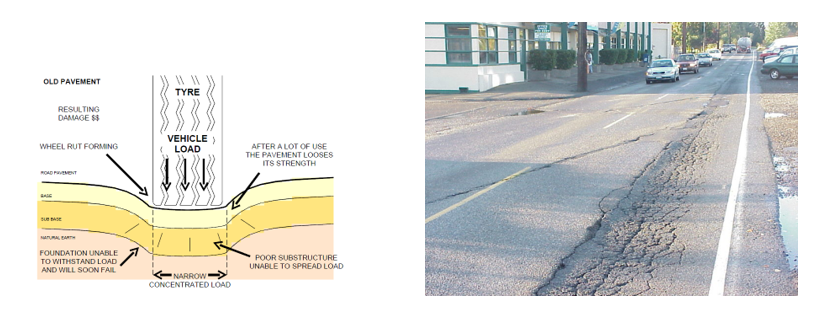
Alligator crack or map cracks – Fatigue Failures
Fatigue failure is the structural distress in asphalt pavements on weakly stabilized bases due to repeated heavy loads.
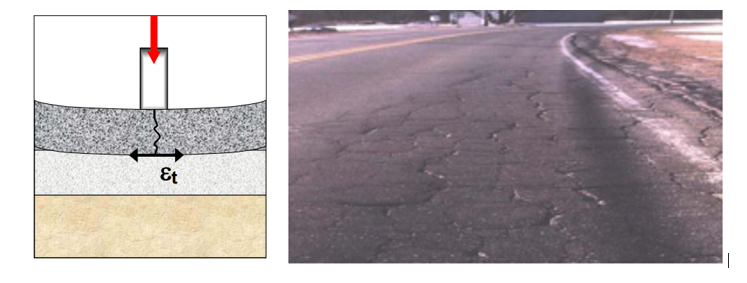
- Shear failure cracks
Shear failure occurs due to the inadequate stability of pavement under heavy loads.
- Lack of binder to the lower course
Wear off the surface materials due to lack of binder content and create potholes with the traffic. Pavement failures get starts with penetrating water in to the subsequent layers of the road pavement.
- Reflection cracks
- Formation of waves and corrugation
The corrugations or shoving occurs at the locations where traffic starts or stops. The bitumen is getting softer with increasing temperature and create plastic movements.

- Bleeding
When the bitumen binder fills the voids of the aggregate during hot weather, it will flow over the surface and created a sticky surface. This will not reverse during the cold period.
- Pumping
Decrease the structural support and settle the pavement due to slowly removal of base, sub base or sub grade materials with drains.

- Problematic subgrade condition (expansive soil subgrades)
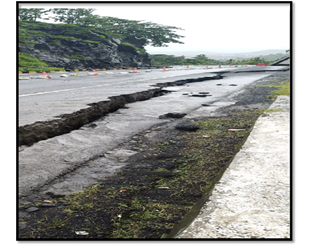
Highly clay soils (problematic soils) are very sensitive with the moisture content and it swells during the wet weather and shrink during the dry weather conditions. Periodic variation of this shrink and swell behavior creates pavement cracks.
All above top-order reasons are encountered usually during the investigation, design, or construction stages. However, the deterioration due to expansive soil subgrade conditions is not a popular parameter that evaluates during the site investigation phase in the current practice.
Expansiveness depends on the clay content of the sub-grade material. If the availability of clay minerals like montmorillonite, kaolinite, smectite etc. are higher in content, then the expensiveness will be more. Volumetric changing of these minerals causes the expansiveness of a soil. Expansive soils swell significantly during wet weather and shrink during the dry period. Cracks propagate in the road pavement as a result of this periodic volume change with seasonal rain patterns.
The research is undertaken to investigate the effect of subgrade in problematic expansive soils. Three locations from Dambulla – Habarana section of A006 road (heavy traffic road) and two locations from Inamaluwa – Sigiriya road (light traffic road) were selected. Furthermore, we monitored the crack widths during the wet and dry weather periods separately and also the periodic variation of crack widths during two seasons. These variations are shown in following figures.
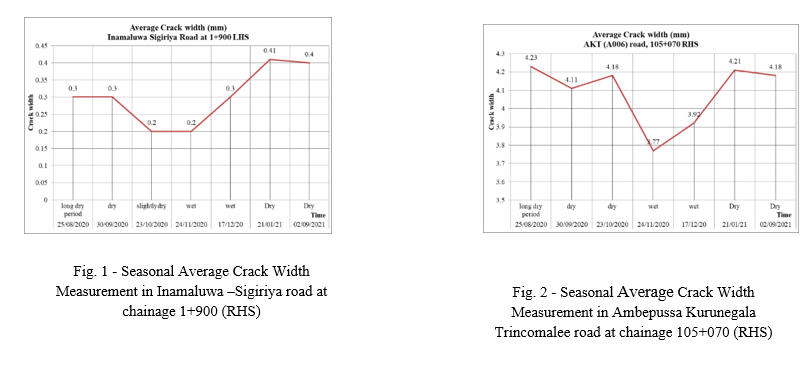
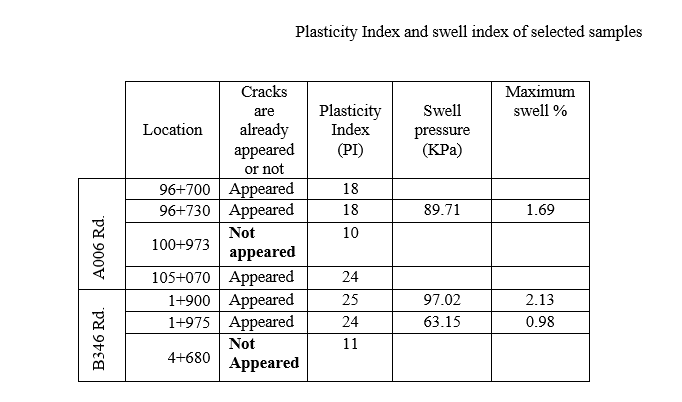
The “Plasticity Index” (PI) is the numerical difference between its Liquid Limit and the Plastic Limit. It represents the range of water content of the soil. Highly clayey soils represent high PI values. Therefore, several relation ships have been derived with the PI and the swell potential of a soil.
Soil classification by Nelson and Millar in 1992;

According to the above classification, if the Plasticity Index (PI) value is 15-28 then the swell potential is medium and it has high swell potential if it is greater than 25. Therefore, it was realized that the subgrade soil was moderately swell at the areas where cracks appeared than other locations.
Degree of Expansion is the volume change due to increase in water content of expansive soils.

Accordingly, it was evident that the expansive soil subgrade would be one of the major reasons for propagating cracks in newly constructed road pavements which is shown in following figure. There is a high potential for such failures in Matale, Anuradapura, Polonnaruwa, Trincomalee, Puttalam, and Kataragama areas where the subsurface subgrade conditions are clay.

Several kinds of research have been done using various types of stabilizers to overcome the situation and we plan to use lime–fly ash slurry as the stabilizer considering several parameters. The pressure injection method will be used as a non-destructive method to apply the stabilizer. It was planned to verify the improvement of settlement with a pneumatical model analysis with PLAXIS 2D software.
This research is carrying out under the supervision of Dr. A.M.R.G. Athapaththu, Senior lecture, Faculty of Engineering, University of Peradeniya to verify the impact of swell potential for the deterioration of road pavements in Sri Lanka. W. A. W. Ayomi and D. G. T.P. Premachandra are two undergraduates who also participated as partners for this research.
 Eng R M Panchula Ratnayake
Eng R M Panchula Ratnayake
BSc. Eng MIESL CEng.
(Executive Engineer, Road Development Authority, Nalanda)
Secretary, IESL Kandurata Chapter




